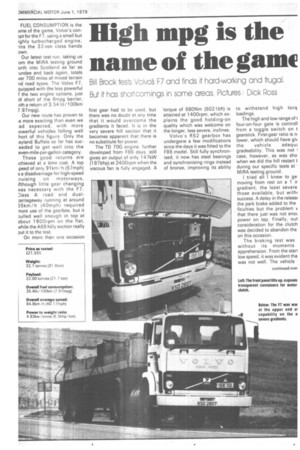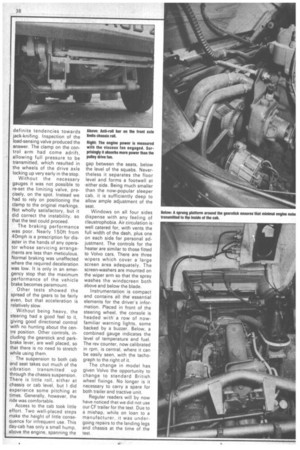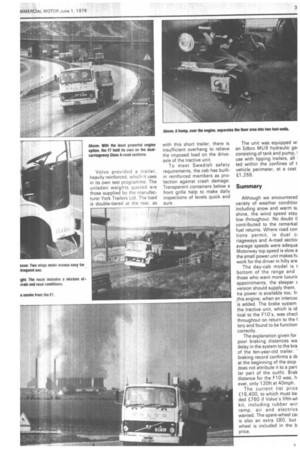High mpg is the
Page 39

Page 40

Page 41

If you've noticed an error in this article please click here to report it so we can fix it.
name of the game
Bill Brock tests Volvo F7 and finds it hard-working and frugal. But it has shortcomings in some areas. Pictures Dick Ross
FUEL CONSUMPTION is the ame of the game, Volvo's conapt for the F7, using a small but ighly turbocharged engine, 'ins the 32-ton class hands own.
Our latest test run, taking us om the MIRA testing ground orth into Scotland as far as undee and back again, totals ver 700 miles of mixed terrain nd road types. The Volvo F7, quipped with the less powerful f the two engine options, just 311 short of the Bmpg barrier, rith a return of 3.54 lit/100km 7.97mpg).
Our new route has proven to e more exacting than even we ad expected, with more iowerful vehicles falling well hort of this figure. Only the .eyland Buffalo so far has suceeded to get well into the even-mile-per-gallon category. These good returns are ichieved at a time cost. A top .peed of only 91km /h (57mph) s a disadvantage for high-speed :ruising on motorways, athough little gear changing as necessary with the 17. :lass A road and dual:arriageway running at around 35km /h (40mph) required nore use of the gearbox, but it 3ulled well enough in top at about 1600rpm on the flat, Nhile the A68 hilly section really put it to the test.
On more than one occasion
first gear had to be used, but there was no doubt at any time that it would overcome the gradients it faced. It is in the very severe hill section that it becomes apparent that there is no substitute for power.
The TO 70G engine, further developed from F86 days, still gives an output of only 147kW (197bhp) at 2400rpm when the viscous fan is fully engaged. A
torque of 680Nm (5021bft) is attained at 1400rpm, which explains the good holding-on quality which was welcome on the longer, less severe, inclines.
Volvo's R52 gearbox has undergone a few modifications since the days it was fitted to the F86 model. Still fully synchronised, it now has steel bearings and synchronising rings instead of bronze, improving its ability to withstand high torq loadings.
The high and low range of1 four-on-four gate is controll from a toggle switch on t gearstick. First-gear ratio is lower, which should have gi% the vehicle adequ■ gradeability. This was not 1 case, however, as was sho when we did the hill restart t during our specific tests at • MIRA testing ground.
I tried all I knew to ge moving from rest on a 1 ir gradient, the least severe those available, but with success. A delay in the mien' the park brake added to the ficulties but the problem v that there just was not enot power on tap. Finally, out consideration for the clutch was decided to abandon the on this occasion.
The braking test was without its moments apprehension. From the star low speed, it was evident tha was not well. The vehicle
definite tendencies towards jack-knifing. Inspection of the load-sensing valve produced the answer. The clamp on the control arm had come adrift, allowing full pressure to be transmitted, which resulted in the wheels of the drive axle locking up very early in the stop.
Without the necessary gauges it was not possible to re-set the limiting valve, precisely, on the spot. Instead we had to rely on positioning the clamp to the original markings. Not wholly satisfactory, but it did correct the instability, so that the test could proceed.
The braking performance was poor. Nearly 1 50ft from 40mph is a prescription for disaster in the hands of any operator whose servicing arrangements are less than meticulous. Normal braking was unaffected where the required deceleration was low. It is only in an emergency stop that the maximum performance of the vehicle brake becomes paramount.
Other tests showed the spread of the gears to be fairly even, but that acceleration is relatively slow.
Withput being heavy, the steering had a good feel to it, giving good directional control with no hunting about the centre position. Other controls, including the gearstick and parkbrake lever, are well placed, so that there is no need to stretch while using them.
The suspension to both cab and seat takes out much of the vibration transmitted up through the chassis suspension. There is little roll, either at chassis or cab level, but I did experience some pitching at times. Generally, however, the ride was comfortable.
Access to the cab took little effort. Two well-placed steps make the height of little consequence for infrequent use. This day-cab has only a small hump, above the engine, spanning the gap between the seats, below the level of the squabs. Nevertheless it separates the floor level and forms a footwell at either side. Being much smaller than the now-popular sleeper cab, it is sufficiently deep to allow ample adjustment of the seat.
Windows on all four sides dispense with any feeling of claustrophobia. Air circulation is well catered for, with vents the full width of the dash, plus one on each side for personal adjustment. The controls for the heater are similar to those fitted to Volvo cars. There are three wipers which cover a large screen area adequately. The screen-washers are mounted on the wiper arm so that the spray washes the windscreen both above and below the blade.
Instrumentation is compact and contains all the essential elements for the driver's information. Placed in front of the steering wheel, the console is headed with a row of nowfamiliar warning lights, some backed by a buzzer. Below, a combined gauge indicates the level of temperature and fuel. The rev counter, now calibrated in rpm, is central, where it can be easily seen, with the tachograph to the right of it.
The change in model has given Volvo the opportunity to change to standard British wheel fixings. No longer is it necessary to carry a spare for both trailer and tractive unit.
Regular readers will by now have noticed that we did not use our CF trailer for the test. Due to a mishap, while on loan to a manufacturer, it was undergoing repairs to the landing legs and chassis at the time of the test. Volvo provided a trailer, heavily reinforced, which it uses in its own test programme. The unladen weights quoted are those supplied by the manufacturer York Trailers Ltd. The load is double-tiered at the rear, as with this short trailer, there is insufficient overhang to relieve the imposed load on the driveaxle of the tractive unit.
To meet Swedish safety requirements, the cab has builtin reinforced members as protection against crash damage. Transparent containers below a front grille help to make daily inspections of levels quick and sure.
The unit was equipped w an Edbro MU9 hydraulic ger consisting of tank and pump, use with tipping trailers, all • ted within the confines of t vehicle perimeter, at a cost £1,255.
Summary
Although we encountered variety of weather conditior including snow and warm st shine, the wind speed stay low throughout. No doubt ti contributed to the remark& fuel returns. Where road con tions permit, ie dual cr riageways and A-road sectioi average speeds were adequa Motorway top speed is slow a the small power unit makes work for the driver in hilly are The day-cab model is 1 bottom of the range and those who want more luxuric appointments, the sleeper c version should supply them. tra power is available too, fr ,this engine, when an intercoc is added. The brake system the tractive unit, which is id tical to the F 10's, was checl throughout on return to the 1 tory and found to be function correctly.
The explanation given for poor braking distances wa delay in the system to the bra of the ten-year-old trailer. braking record confirms a dE at the beginning of the stop does not attribute it to a part lar part of the outfit. Brak distance for the F10 was, h ever, only 120ft at 40mph.
The current list pricE £19,400, to which must be ded £760 if Volvo's fifth-wl kit, including rubber wir ramp, air and electrics wanted. The spare-wheel car is also an extra £80, but wheel is included in the b












































































































